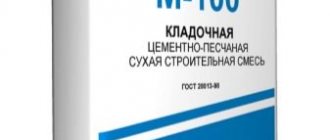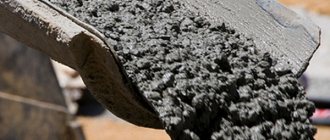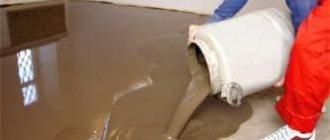SOLUTION BRAND M150
Order
| Brand | Frost resistance F | Styling brand | Price per 1 m3 (with VAT 20%) | |
| Masonry | Mounting | |||
| M150 | 75 | PC3 | 3150 rub. | 2900 rub. |
Cement-sand mortar M 150 is popular in the construction market due to its strength and high characteristics.
This is achieved through the use of Portland cement as a binder additive. This does not make it possible to mix the M 150 solution with others, but it increases viscosity and strength. Thus, the material is ideal for creating, grouting, masonry work, creating floor screeds in conditions of “weak” soils or high humidity. produces mixture M 150 in accordance with GOST 28013-98 “Building Mortars”, delivers it to customers completely ready for use. Cement mortar is supplied in special automixers with a capacity of 7, 8, 9, 10 cubic meters, so the order must be a multiple of these volumes.
Technical characteristics of the M150 solution
- mortar strength - B12.5
- frost resistance of the solution - F50
- workability of the mortar - PK3
- solution density - up to 2000 kg/sq.m.
The characteristics of the material can be changed at the request of the customer by adding various plasticizers, retarders, etc. The characteristics of the mixture provide increased heat and sound insulation in the premises, and the solution itself is highly homogeneous and plastic.
The material is suitable for sealing seams, preparing various surfaces for painting or wallpapering, as well as for forming foundations or walls with increased waterproofing requirements.
The M 150 mixture is made from fine river sand, M400 or M500 cement, water, and air-entraining additives. The ratio of cement and sand is 1:1.67. When using M 150, it should be taken into account that it hardens in 3-4 hours, and completely hardens in 28-30 days.
By purchasing cement mortar directly from the factory, you are protected from the use of commonly found Turkish cements, which are of poorer quality and have low adhesion.
The entire process of making the solution is carried out on modern equipment under automatic control.
Properties of cement-sand plaster
Dry CMC mixture M150 is used for plastering walls, ceilings and other surfaces and is a universal construction mixture. In addition, this material can be used provided that subsequent processing involves painting, filling and wallpapering.
Cement-sand mixture M150 can be used for laying walls, concreting stairs, repairing floors, sealing concrete walls and areas where there is fallen plaster. This composition can be applied to surfaces made of concrete, brick and cement. The thickness of the applied layer will be 5-50 mm.
You can find out how long it takes for a cement floor screed to dry in the article.
The cement plaster and masonry mixture M150 is characterized by the following properties:
- Possibility of leveling walls and ceilings without using plaster stacks. In this case, the layer should have a thickness of 30 mm.
- High degree of adhesion to various substrates.
- Vapor permeability.
- Weather resistance.
- Frost resistance.
- Can be used for interior and exterior work.
The cement consumption per 1 cubic meter of solution is the amount specified in this article.
The video shows the technical characteristics of cement sand mortar (CSM) m 150:
Purchase of M150 solution
There are several convenient ways to purchase:
- fill out the online order form on the website
- contact us by email
- order by phone
- order a call back
If you have any questions, call / 8-967-593-17-23 (Anna) or use the feedback form. Our specialists will help you! We are waiting for your applications!
Calculator for calculating the amount of solution
Composition of the dry composite mixture
A very important role is played by strict adherence to the proportionality of the included ingredients in the composition of the dry mixture. Exact observance of which provides the material with universal characteristics - it does not flow off the surface and does not delaminate.
Classic dry mix composition:
- Portland cement m15 is the basic binder component;
- Clean, washed fine-grained river sand as the main filler;
- Additional fillers: various plasticizers and quality characteristics improvers;
At first glance, sand concrete 150 resembles an ordinary concrete mass, which is not surprising, because this building material is a type of concrete. But the additional mineral and organic additives included in the composition give the building material truly universal properties and enhance its quality characteristics.
By the way, plasticizing additives included in the dry mixture significantly reduce the level of costs per unit of production and significantly extend the service life of structures.
Other brands of solution
M50 solution
M75 solution
Solution M100
Solution M125
M200 solution
Solution M250
Our advantages
Stable
quality
We test concrete in our own laboratory
Low
prices
Wholesale prices for building materials
Rent
Special equipment
Concrete pumps and concrete mixer trucks in stock
Operational
delivery
Timely shipment of concrete, meeting deadlines
Accredited laboratory
We deliver concrete throughout St. Petersburg and Leningrad Region
Realized objects
Pouring the foundation for a cottage in the Vsevolozhsk region
Construction of an office building in Yanino
Construction of the SKA arena near the Prospekt Bolshevikov metro station
Construction of a residential complex on Kondratievsky Avenue
Construction of cottages in the village of Manushkino
Construction of a kindergarten in the Krasnogvardeisky district
M150 mortars with delivery Moscow and region
One of the varieties of lightweight concrete mixtures is cement-sand mortar M150. The Homestroy company offers to buy M150 mortar to perform various types of construction operations:
- to make a screed;
- for masonry work using bricks or cinder blocks;
- for installation, plastering and other work that requires cement mixtures.
The main advantages of the M150 solution are its affordable price and high strength. Among all brands of cement mortars, it is consistently in demand, since it surpasses the cheapest M100 in parameters (their compositions are similar), and prices per cubic meter differ slightly.
| Delivery prices | |||||
| Distance from RBU, km | Price per cubic meter in rubles including VAT | Distance from RBU, km | Price per cubic meter in rubles including VAT | ||
| 0-10 | 420 | 35-40 | 740 | ||
| 10-15 | 480 | 40-45 | 800 | ||
| 15-20 | 530 | 45-50 | 850 | ||
| 20-25 | 580 | 50-55 | 900 | ||
| 25-30 | 640 | 55-60 | 960 | ||
| 30-35 | 690 | ||||
Area of use
Based on the characteristics of the material listed above, a clear appropriate area of application of the material is determined. Since sand concrete mixture M150 is a truly universal building material, it is used at almost all stages of construction work.
Sand concrete grade M150 is used in the construction of unloaded and moderately loaded building structures. The high performance and technical characteristics of M150 sand concrete allow the mixture to be used in almost all rough and finishing construction work.
The high level of water resistance allows you to treat the internal and external walls of residential premises with the solution. And sufficient frost resistance makes it possible to carry out external construction work using sand concrete even in sub-zero temperatures.
The main area of application of concrete composite:
- The whole range of masonry works (brickwork, paving slabs). Used in road surfaces. Provides strong and reliable adhesion of surfaces, extends service life;
- Ideal for initial plastering work. Perfectly levels ceilings and walls;
- Construction of walls and various partitions;
- Sealing and fastening seams and cracks of reinforced concrete structures;
- Internal screed pouring and concreting of floors;
- Preparatory stages of construction work, pouring light foundations and preparing a foundation cushion;
- A wide range of uses in installation work, such as concreting pillars.
It is noteworthy that I would like to highlight the ease of working with M150 sand concrete mixture! In order to perform high-quality finishing work, it is enough to have minimal knowledge and skills.
How to calculate the weight of cement for preparing building mixtures
When calculating the necessary ingredients for preparing concrete or mortar, novice builders have difficulties. The amount of mixture for work is determined in cubic meters, and cement is measured in kilograms. It is sold in bags in standard packaging of 25 and 50 kg.
Cheat sheet for preparing different grades of concrete Source cemmix.ru
To calculate how much a bag of cement weighs (more precisely, its volume), use the average density - 1300 kg / cubic meter. m. Therefore, 1 cubic. m of material weighs 1300 kg. A 25 kg bag has approximately a volume of 19 liters, a 50 kg bag has a volume of approximately 38 liters.
A bucket of cement (standard 12 liters) will weigh 15.6 kg. The mass of the material can also be determined experimentally. It is enough to weigh the mixture directly in the bucket, after subtracting the weight of the container. If the measured value differs greatly from the calculated value (15.6 kg), the quality of the material can be suspected. To determine its approximate density, the resulting weight must be divided by the container volume.
Composition and proportions
The M150 concrete grade contains cement, sand, coarse aggregate, water and special additives. When they are mixed, a building material with the given properties is obtained:
- Cement, which makes up approximately 11% of the entire mixture. For preparation, use Portland cement (I-II 32.5). It makes no sense to use high grades, because their consumption will decrease. Be sure to check the date of manufacture and end use. Cement that has expired loses quality.
- Sand. Most of all, a sand component with a particle size of 1.5-2 is used for the composition. It is cleaned of contaminants and washed well.
- Large aggregate. Most often, gravel or limestone is used. The particle size of crushed stone should be from 5 to 20 mm. Cleaning from foreign dirt will preserve the quality of the future concrete solution.
- Water must be purified from chemical and biological additives.
- Chemical additives are used to give concrete frost resistance and moisture resistance, to improve the strength of the composition.
Proportions for self-cooking
There are two ways to obtain concrete of this grade at a construction site. Order ready-made material from the nearest concrete plant or prepare the product yourself using universal tools and a concrete mixer.
For large volumes of pouring, it is more advisable to order delivery of concrete. For local work, it is advantageous to produce the material yourself by mixing the components in accordance with the following tables.
Table of proportions for concrete M150 per 1m3
| Cement brand | Proportions, kg C:P:SH:V | Cement, kg | Sand, kg | Crushed stone, kg | Water, l |
| TsEM I 32.5N PC | 1:3,4:5,3:0,9 | 215 | 735 | 1140 | 190 |
| TsEM I 42.5N PC | 1:4:6::6:1 | 190 | 755 | 1140 |
Table of proportions for concrete M150 in buckets per 1 m3
| Cement brand | Cement, number of buckets (10 l bucket) | Sand, number of buckets (10 l bucket) | Crushed stone, number of buckets (10 l bucket) | Water, number of buckets (10 l bucket) |
| TsEM I 32.5N PC | 16,5 | 52,5 | 81,5 | 19 |
| TsEM I 42.5N PC | 14,6 | 54 | 81,5 |
To make your own concrete, you can use a mechanical concrete mixer or a large sheet of iron placed on bricks.
Briefly about the main thing
Experts distinguish true and bulk densities of cement, which differ significantly from each other. Also, this indicator is influenced by many factors - mixture composition, duration and quality of storage, production technology, strength brand.
Determining the specific gravity of cement powder is quite simple at home. For this you will need a scale and a measuring cylinder. Also, the approximate density of the material can be determined directly at the construction site by weighing a bucket filled with cement.
Density value for different types of cement powder
The regulatory construction documentation indicates the following density indicators for different types of cement (true/bulk, kg/cub.m):
- pozzolanic – 2800/900;
- slag – 2900/1200;
- aluminous – 3100/1100;
- Portland cement – 3200/1200.
The bulk density of M500 cement is 1300 kg/cubic. m. This is a standard value for a reference material that does not contain additives and is stored under ideal conditions. The bulk density of cement M400 is 1200 kg/cubic. m. For material of the same brand, which is characterized by a long setting time, this figure is 1500 kg/cubic. m.
Definition of concepts
Cement is a granular, fine-grained material. It is not a homogeneous mass. This substance is a mound of microscopic elements, between which there is air. Therefore, its density does not have a single meaning. To define this characteristic, two terms are used:
- true density;
- bulk density.
The specific gravity of cement is defined as the ratio of mass in kg to volume in cubic meters. m. Dividing these values gives the desired result. To obtain the first parameter, the mass is taken into account, which consists exclusively of grains of building material without air particles. True density is an indicator found in educational and methodological literature. When determining this parameter, it is assumed that the substance is monolithic.
Bulk density is more important to builders. It indicates the specific gravity, taking into account the air that is between the particles. Powdered substances always take up more space in space. Therefore, its true density will be significantly less.
Structure of cement under a microscope Source docplayer.ru
Preparing sand concrete for work
Sand concrete dry mix, presented on the construction market, is an almost ready-to-use material. Add clean water to the dry mixture in the recommended proportion and stir using a drill with an attachment until a homogeneous consistency.
The low cost and ease of working with sand concrete of this brand is a convenient option for use on private construction sites.
To prepare the finished solution, you need to carefully calculate the correct proportions of the required amount of dry bagged mixture. For example, a package of sand concrete m150 50 kg will require about 6 liters of clean water.
To obtain the stated strength of the solution, it is necessary to strictly adhere to the permissible proportions of water + dry mixture. The proportion of water for mixing the ideal solution is indicated in the instructions included with each package. It is not recommended to dilute the prepared solution with water during operation.
Basically, 10 kg of dry mixture requires 1.6 -1.8 liters of clean water. It is allowed to change the proportional amount of incoming ingredients, depending on the required mechanical properties of the solution.
It is important that the composition of the mixture in mass fractions of the incoming components is so qualitatively balanced that the solution has minimal drawdown. This greatly simplifies the calculation of the required amount of dry mixture. The volume of the dry mixture practically coincides with the yield of the finished solution.











